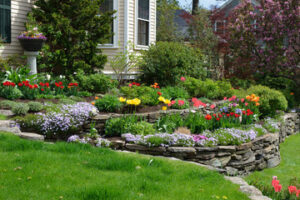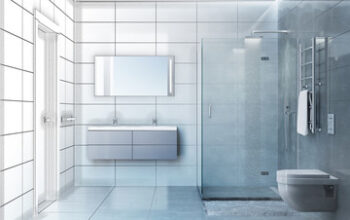Landscapes create curb appeal for homes and add value to property. They also provide functional improvements like improved privacy, security, and water management.
To make a garden more polished, use lines to direct the eye toward a focal point like a statue or fountain. This can be done using color or line: for example, drawing attention to a statue by reducing clutter and arranging a ring of flowers around it. Contact Eccograss Landscaping for professional help.
One of the most important aspects of landscape design is color. It sets the tone for the entire space, drawing the eye toward key features and creating visual balance. There are many different colors to choose from, and each can have a unique impact on the landscape.
Some colors are bold and contrasting, while others are soft and soothing. Bold colors can be used sparingly to highlight focal points or to draw attention to specific elements, such as a flower bed. Softer colors can add depth and interest to the overall landscape, and can be used to create contrast with a variety of plant colors and textures.
In the past, landscape designers have primarily focused on establishing an appropriate relationship between a house and its environment. However, with the growing emphasis on wellness and the need for employees to have access to outdoor spaces that allow them to exercise outdoors, we’re seeing a shift in how commercial landscaping is planned and implemented. Some businesses are now installing fitness trails, soccer fields, basketball courts and other amenities in their landscaping plans.
Form
Landscapes are composed of many things, including flowers, shrubs, trees and hardscape features like paths and patios. Form refers to the shape of these elements, which helps define how they fit together and creates balance. For example, a garden with a more formal character would feature straight lines in its plantings like trimmed hedges, while an informal landscape might use curved lines in its plants and garden ornaments such as statues or urns.
Line is a vital element in a landscape because it creates movement and directs the eye where it should go. The type of line used in a landscape can make it look symmetrical or casual, or even chaotic. Whether lines are straight or curved, they help set the mood for the overall design of a space and influence people’s emotions and reactions.
Texture is another aspect of landscape design, and it refers to the roughness or smoothness of surfaces. It is perceived mainly by touch, but can also be imagined through the visual senses. For instance, the texture of earth can range from fine sand or silt to coarse clods or gravel, while the texture of plant coverage can vary from soft grasses to brush and ivy.
The addition of a water feature, such as a pond or stream, adds movement and interest to any yard. It can also serve as a focal point and add beauty to your landscaping. For a more natural touch, use recirculating fountains and water features instead of pumping water directly into your garden or yard.
Texture
While color may be the most popular element of landscape design, texture is equally important for creating a visually stimulating and sensory appealing garden. Plants with varying textures play off each other to add depth and interest. The combination of plant textures can also evoke moods and atmospheres that are distinct to your garden space. For example, combining fine and coarse textures creates visual contrast that draws the eye. This can be achieved by pairing plants with contrasting foliage or adding accents like ornamental grasses and dainty flowers that contrast with larger-leafed hostas and elephant ear plants.
Texture is defined by the visual and tactile qualities of a plant – how rough or smooth, coarse or fine, its leaves and branches feel. A plant’s texture can change depending on the viewing distance, lighting and the way other plants around it combine to form a whole. For example, up close, needle-leafed trees have a fine texture, but when viewed from a distance, the plants blend together into a coarse texture.
Plants are usually categorized as either fine, medium or coarse based on their leaf size and branching structure. Fine-textured plants are characterized by small leaves or delicate foliage, while coarse textures are characterized by large and rugged leaves. Medium-textured plants have leaves that are neither too big nor too small and produce a balanced look.
Contrasting textures within a garden create an eye-catching effect, drawing the eye and providing a sense of movement and dimension. For example, pairing fine-textured silver lace dusty miller with coarse-leafed red salvia produces an attractive combination. This pairing highlights the distinctively textured foliage of the dusty miller while the coarse-leafed red salvia complements it with its bold, dramatic shape.
In addition to the textures of plants, other non-plant elements such as gravel, stone and wood are considered important textural components in a landscape. Incorporating these elements can help to establish a balance and harmony between the different parts of your garden.
It’s also important to consider the different seasons when designing with texture. For example, deciduous trees and shrubs offer a variety of textures during the winter when they are bare and in dormancy, as well as their full lush foliage in summer.
Light
A great landscape photo is about more than just the foreground – it’s about light and shadows that add depth, drama, and interest. The light in a scene can make or break an image, and it’s something that landscape designers consider with every element they incorporate into a design.
A well-designed lighting system offers a new perspective on your landscape and can transform your home into a beautiful nighttime retreat. By illuminating trees and architectural features, you can create dramatic shadow effects and highlight your landscape in ways that wouldn’t be possible during the day.
The best landscape lighting designs balance functionality with aesthetic finesse. Illuminating paths and entryways ensures safety, while low-level lights that cast pools of soft illumination create an enchanting atmosphere. Choosing colors that complement your landscaping and home’s architectural style allows for an integrated, harmonious ambiance in your outdoor spaces.
Illuminating the bases of tall, majestic trees is a classic landscape design technique that highlights their beauty and creates striking silhouettes against the sky. Uplighting can also highlight architectural elements or sculptural plantings, adding dimension and making them stand out at night. The light that reflects off the surfaces of water and other features can produce beautiful reflections and shadows, further enhancing their appearance.
With a variety of lighting techniques at your disposal, it’s important to find the right solution that accentuates your property’s unique features and satisfies your personal preferences. The experienced professionals at Walpole Outdoors understand the importance of blending landscape lighting with your design aesthetic and can help you choose fixtures that work seamlessly with your landscape and home.
Landscape lighting is a valuable investment that not only increases the value of your home, but it also extends the usable hours of your outdoor space. At night, a well-lit terrace can be transformed into an intimate setting for dinner parties and cocktails, while thoughtfully placed lighting along walkways can ensure safety for family and guests at any time of the day or night.


